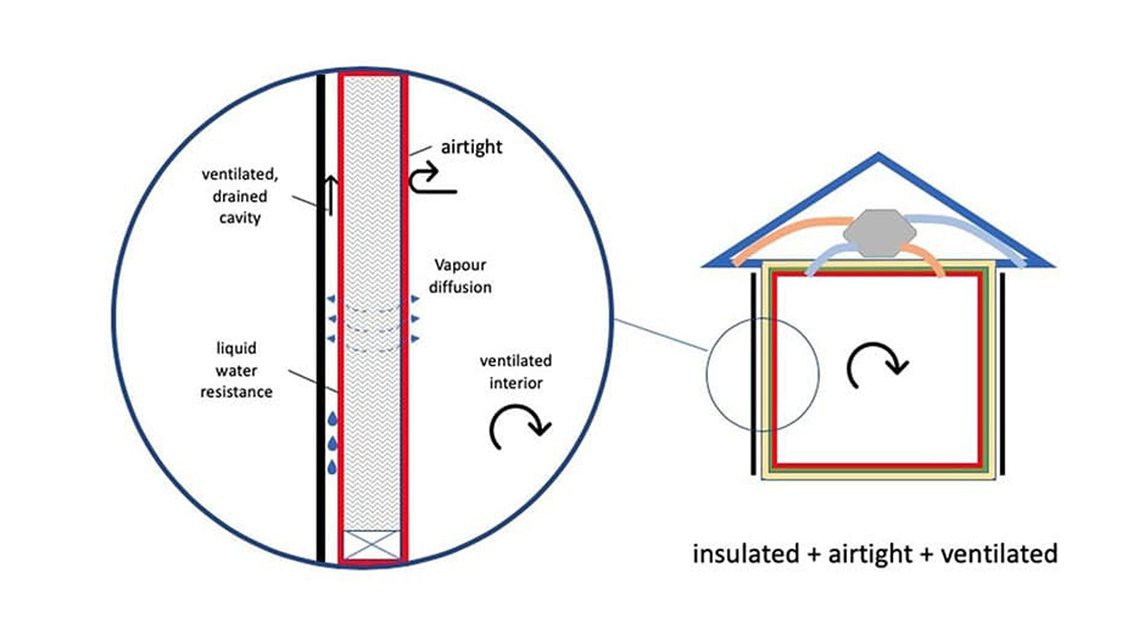Richard Hollard
October 21, 2019


This month, we look at "airtight" vs "breathable" building. Is it possible to achieve both within the same build?
John, a homeowner customer, called me the other day to say he was planning to build a new home. After reading about building products, he decided that he wanted to build a "breathable" home. He had also been talking to someone else about making his building airtight and was calling to ask me which one he should go for: "Breathable" or "Airtight".
The short answer is that John can have both or should have both if he is building a timber-framed house with fibrous insulation (like the majority of houses are).
In NZ, the term "breathable" is commonly used (even if technically incorrect) to describe a building material or system that is vapour permeable or vapour open; in other words, a material that allows the construction to dry by letting any retained moisture escape in the form of vapour (the gaseous form of moisture). It’s not technically "breathing" they are trying to describe though, but more "transpiring" as it often doesn’t involve air movement in and out.
As a building consultant once said:
If you’re in something that’s breathing, get out fast, as you’ve been eaten alive!
So yes, we do need to build our homes to be "breathable" or "vapour open" so moisture is not trapped in the structure, and they can be free from moisture problems such as mould growth and rot.
Airtightness, on the other hand, refers to controlling air movement in and out of gaps and cracks in our thermal envelope, which includes our floors, walls and ceilings (or systematic draught stopping). Insulation is basically the trapping of air molecules, so if we are allowing air movement through our insulation (from outside or inside), then we won’t be getting anywhere near the expected R-value required in our thermal envelope to ensure the inside temperature of our homes can be kept at a comfortable level.
A good example of trapped air being a good insulator is if we are outside on a windy day and are wearing a jersey. We might still feel cold, but if we put a windbreaker over top of the jersey, the air around the jersey is trapped or still, so suddenly, we feel warm as we are better insulated (the windbreaker itself is only thin, so it has minimal R-value but allows the jersey underneath to work properly).
Some building materials are both airtight and vapour permeable, like most good-quality wall underlays. Just to confuse you, a material isn’t always vapour-tight if it is airtight (like a good-quality building underlay), but usually, a vapour-tight material will be airtight by nature (i.e., vapour barriers such as foil, steel, or glass).
The thermal envelope of a building should have similar properties to the human body. Our skin is both airtight and watertight from the outside, but vapour permeable as we sweat or "transpire" moisture out if things get a bit humid. Our skin and our insulating fat layers are also continuous around our body to ensure they work effectively everywhere and all the time (that’s another whole discussion for a later date). Coupled with this is the super-efficient ventilation system you are using right now, breathing fresh air in and extracting carbon dioxide out as you exhale.
Just think: For you to "breathe", what we are talking about is transferring air in and out of your dedicated opening (mouth). The last thing you want is to try to "breathe" through holes in your lungs (ventilation casing), chest (building envelope), or trachea (ductwork), as then you are in real trouble.
Like our lungs and mouths, a dedicated ventilation system plays a key role in making vapour-permeable and airtight buildings function correctly. It extracts moisture through dedicated pipes and openings instead of any old gaps or cracks in our walls, floors, and ceilings.
So if John (or anyone else!) builds with air-tightness, vapour permeability and good ventilation in mind, they are well on the way to having a home which is healthy and comfortable to live in, as well as being energy efficient and durable for years to come.
A thermally insulated, airtight building envelope plays a significant role in determining how comfortable and pleasant an indoor environment is for us and how well we can work, learn or relax there. Air temperature has the strongest effect on our perception of comfort level: a temperature range between 20 °C and 23 °C in homes is considered comfortable in winter. Comparatively, temperatures of up to 26 °C are pleasant in summer. In this context, airtightness has a crucial influence on the effectiveness of thermal protection in both winter and summer.